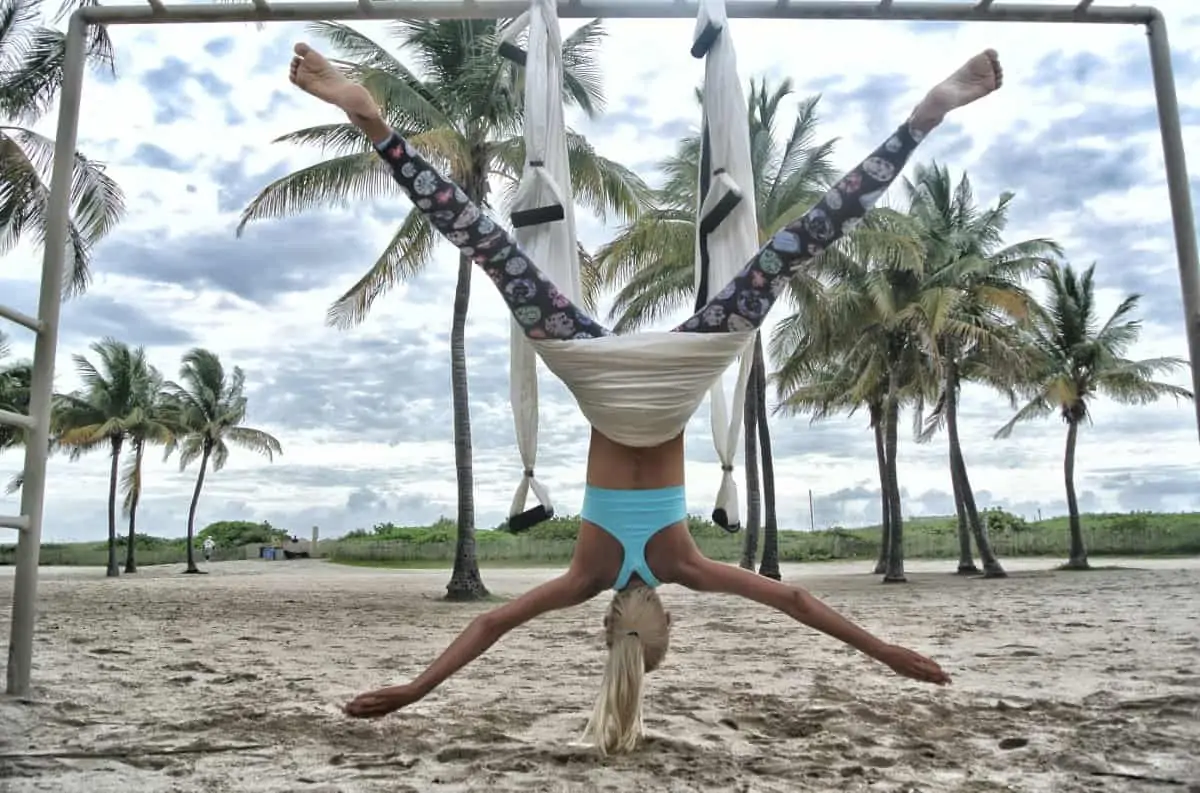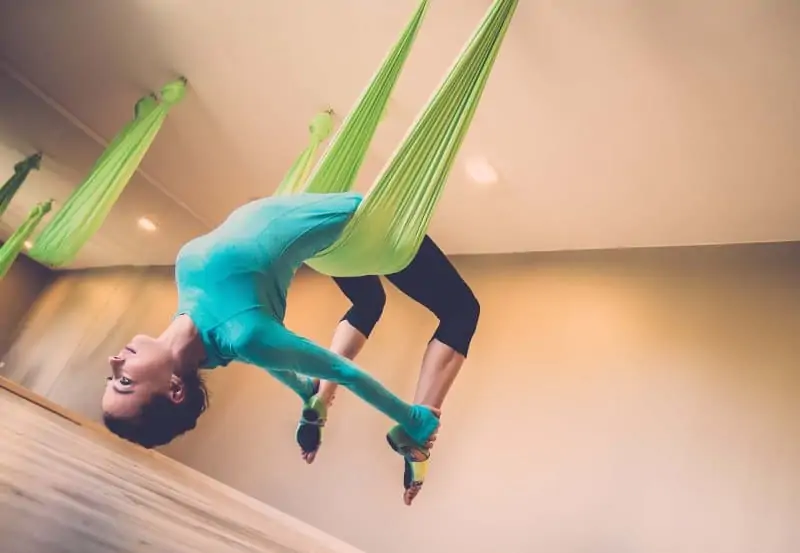Key Takeaway
Discover the rejuvenating power of yoga swing poses that combine the essence of traditional yoga with the therapeutic benefits of aerial acrobatics, offering a safe and versatile way to enhance flexibility, strength, and mental clarity.
Traditional yoga has been a very grounded practice, but now you can zen out while dangling in the air! Don’t worry, it’s far safer and more therapeutic than it sounds. Aerial yoga is growing in popularity as a way to take your yoga practice to the next level. This unique combination of yoga, pilates, and trapeze acrobatics has incredible benefits, such as spinal decompression, back pain relief, and improved posture.
Many yoga swing poses are surprisingly beginner-friendly and oftentimes safer than their typical mat yoga counterparts. That’s because the swing supports you and prevents you from overextending your spine or putting excess pressure on your joints.
Best of all, the broader category of inversion therapy is also known to improve blood circulation and promote mental clarity. If you don’t want to try unsupported handstands or dangle from a gymnastics bar, playing around in your yoga swing could be the perfect midday pick-me-up to de-stress and decompress. Yoga swings can be easily installed right in your home for a quick dangling flow any time you please.
Here are our favorite yoga swing poses for beginners, as well as the best yoga swings on the market, and a brief look at the benefits of this invigorating practice.

Contents
What is a Yoga Swing?
A yoga swing is a strong fabric hammock similar to aerial silk. While the original aerial yogis used only silks in their practice, like you may have seen at a circus, yoga swings tend to have handles and be more beginner-friendly.
Despite the names “yoga swing” and “yoga hammock,” the real benefits of these silky support systems are not from swinging back and forth or lounging around. The most rewarding aerial yoga poses will help relieve back pain, strengthen your core, deepen your stretching routine, and help you experiment with partial or full inversions.
Yoga swings can be mounted on a hook in the ceiling, hung from a tree, or permanently installed on a yoga trapeze stand. Many aerial yoga classes have popped up around the country; however, this graceful flying practice is also easy to do in the comfort of your own home.
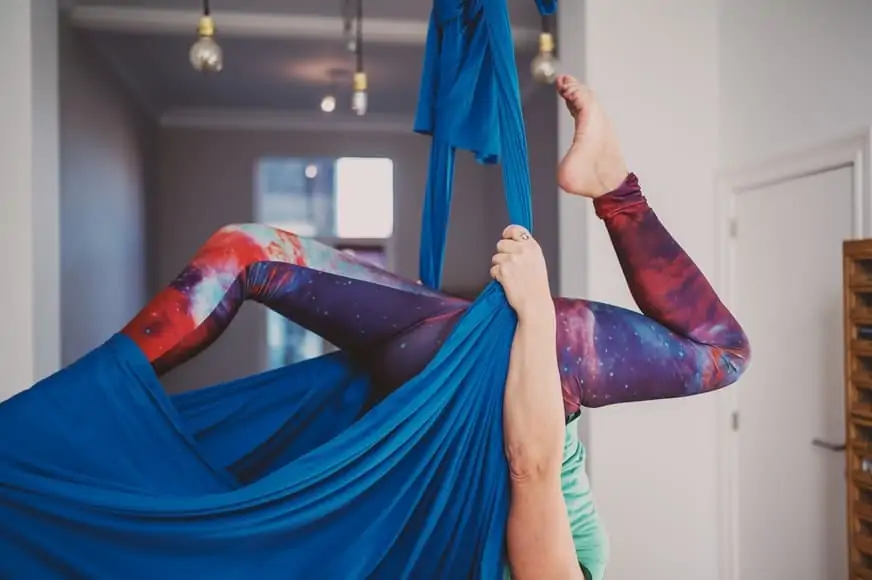
Benefits of a Yoga Swing
Yoga swings are most popular for their inversion therapy benefits, but they can be used for a wide variety of other poses as well. It turns out that stretching with silks and hanging upside down have remarkable benefits for your body, including:
- Spinal decompression (creating space between spinal discs)
- Less risk of spinal pressure and injury
- Improved posture
- Improved circulation and blood flow
- Oxygenation to the brain
- Mental clarity and even sparks of creativity
- Meditation
- More flexibility
- Support for challenging asanas
- Full-body workout
- Stress relief and stimulation of the vagus nerve
- Back pain relief and reduced neuromuscular tension
Nearly any yoga asana can be modified using a yoga swing to make it easier, deepen the stretch, or add a strength-building challenge. How you use a yoga swing and what benefits you experience ultimately depend on your preferences.
Some aerial yoga poses simply use the swing as a prop to modify regular asanas. Other poses offer intense core workouts and cardio. Still, other styles allow you to elegantly flip over and twirl around. Partial or full inversions on the yoga swing tend to offer the most research-based benefits.
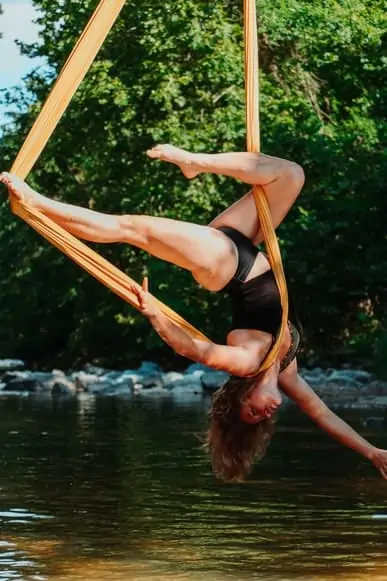
Top 3 Best Yoga Swings for Aerial Yoga
There’s no denying that it feels a little risky to trust silk fabric with your entire body weight. To enjoy all the benefits of aerial yoga swings, you have to be able to trust your yoga hammock in the first place.
In another post, we reviewed the top 6 best yoga swings based on durability, ease of installation, and safety. To narrow it down for you, here are our top 3 picks for beginners:
- Best for Beginners: YOGABODY Yoga Trapeze Pro
- Best Ceiling Mount Option: UpCircleSeven Aerial Yoga Swing Set
- Best Freestanding All-In-One Swing Kit: Happybuy Yoga Sling Inversion Stand
Yoga Swing Safety Tips
Aerial yoga is surprisingly safe and has a very low rate of injury. It’s gentler on the body and you are far less likely to overextend your back or harm your joints. That being said, you definitely can fall out of a yoga swing if you aren’t careful. Be sure to use these safety tips before getting started:
- Start simple: Whether you already have a consistent yoga practice or you’ve never done yoga before, you should start with at least one class with a certified aerial yoga instructor to help you get started. It’s best to master the basics before practicing inversions.
- Don’t eat before your practice: Like most physical activity, aerial yoga poses on a full stomach could be a recipe for disaster. It’s best to wait a few hours for your food to digest before trying out aerial yoga asanas.
- Wear close-fitting clothing: Any baggy or loose yoga outfits could get tangled up in the yoga fabric and end up causing trouble. It’s best to wear close-fitting clothes that cover your skin to prevent “rug burn” from the yoga swing. Certain fabrics create more friction than others, so you may have to experiment. You’ll also want to avoid wearing clothes with zippers, embellishments, or anything that might get caught on the silks and damage the fabric.
- Check with your doctor: If you have medical conditions like vertigo, sciatic, herniated discs, or prescriptions for certain medications, you may want to check with a medical professional before practicing aerial yoga. While it is a predominately safe exercise, it could exacerbate underlying health conditions.
- Get a good grip: Keep your hands clasped to some part of the yoga swing at all times, even in simple poses. I like to wrist wrap the silks at least twice around my arm for an added grip unless there are handles I can firmly hold onto. This will help stabilize you and prevent injuries.
7 Best Yoga Swing Poses for Beginners
Aerial Mountain
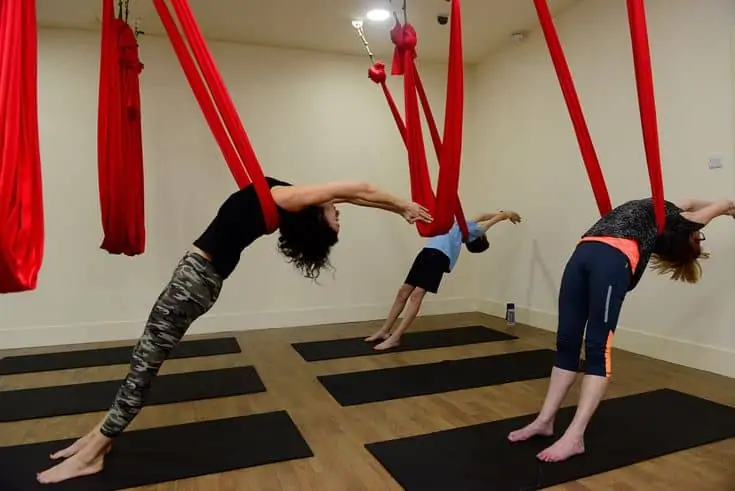
Similar to a standing Mountain Pose (Tadasana), this reclined pose uses the aerial yoga swing to add heart opening and a deep shoulder stretch. Begin by standing with your feet together and the yoga swing behind you. Adjust the silks to rest just above your rib cage. Slowly lean back into the swing, keeping your feet rooted, and reach your arms overhead into a clasped hand position. Allow your heart to open and neck to release as you stretch the whole front of your body in this reclined diagonal position.
Swing-Supported Chair Pose
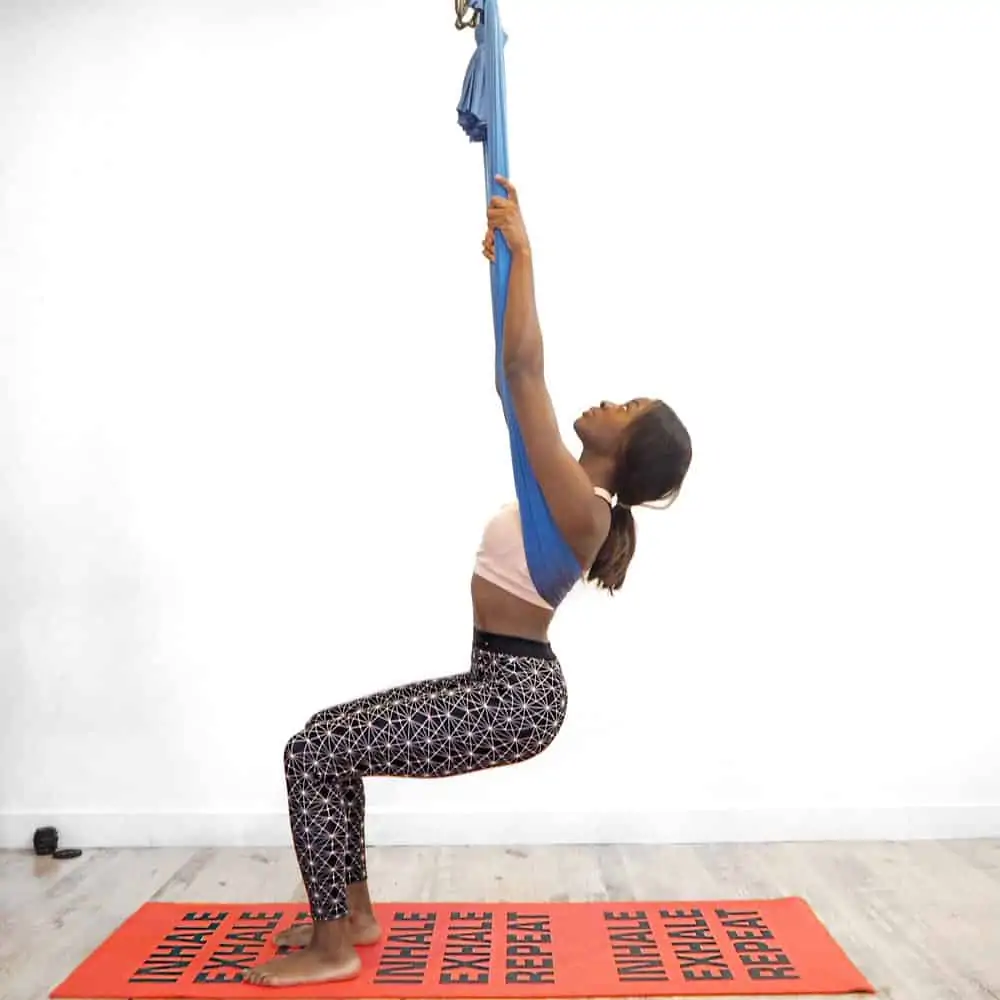
If you aren’t quite ready to go upside down in the yoga swing, this is the best starter pose for you! Begin with your feet firmly on the floor and hands holding the swing on your upper back beneath your armpits.
Bend your knees and slowly lean back and down into a chair pose. There should be a 90 degree angle between your knees and ankles. You can let go of the hammock and allow it to support your back as you hold this position and relax.
Swing supported Chair Pose improves posture and strengthens your quad muscles. It is a great preparation for more advanced poses.
Inverted Bow Pose
If Bow Pose (Dhanurasana) has ever intimidated you on the mat, trying it in a yoga wing may be far more accessible and relieving.
Begin by sitting in the yoga hammock with your body weight evenly distributed. Get a firm grasp on the handles or silks of the yoga swing and slowly bend your back, lowering your head to the floor as you begin to open your heart to the back wall.
Once you feel comfortable, let go of the yoga swing and grab the outsides of your ankles one at a time. Release any tension in your neck and use your ankles as leverage to deepen the stretch if you wish.
Inverted Bow Pose opens up the lungs, stomach, shoulders and back while stimulating your nervous and digestive systems. In this asana, your spine will lengthen and decompress to counteract any time you’ve spent hunched over a computer (guilty here!)
Anti-Gravity Butterfly Pose
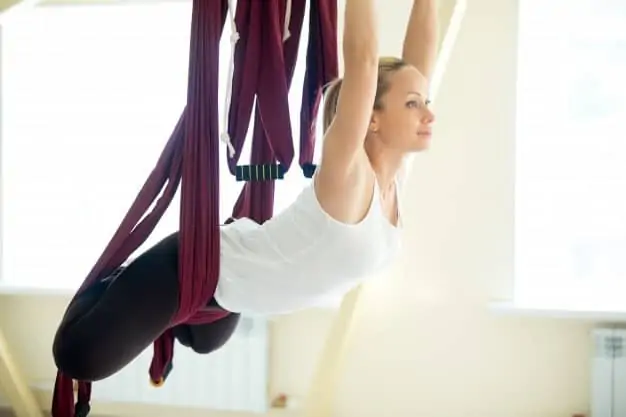
This staple asana is also easy to achieve up in the air on your yoga swing. Butterfly Pose will help get a relaxing stretch and go deeper than you may be able to during mat yoga.
Begin by sitting back on your yoga swing and grasping the handles or silks on each side. Bring the soles of your feet together underneath you and tuck your ankles into the yoga swing beneath your pelvis.
Keep your back straight and core engaged as you bring your palms to the heart center and balance on your butterflied legs. You can also grasp the swing and lean forward for a different angle of hip opening.
Aerial Lunges
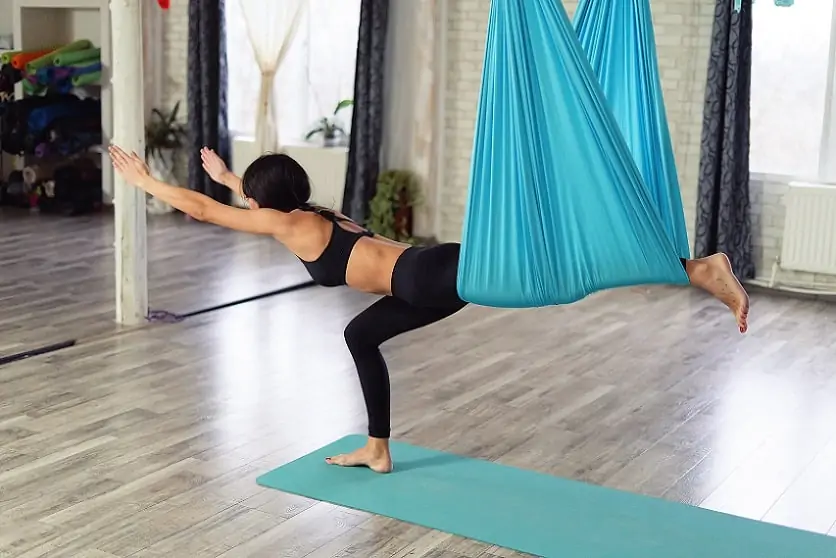
This lunge variation is a nice leg workout with two options. You can either have your front leg or back leg in the yoga hammock. Whichever you choose, you will use it as leverage to deepen your stretch and optionally pulse up and down for a strength challenge. Be sure to keep your glutes engaged and never let your knee shift in front of your ankle (aim for a 90° angle).
Hammock Plank and Pike Ups
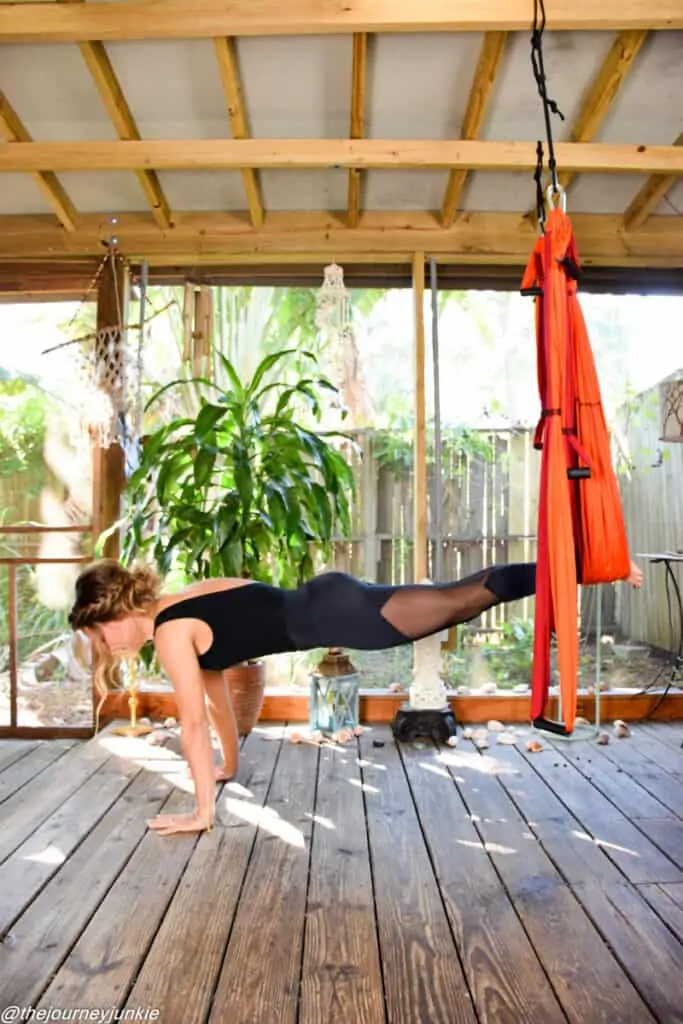
Another great workout for your core muscles, this pose begins in a classic plank position and uses the swing to pike your knees up toward the core. You can start on all fours facing away from the yoga hammock with your hands firmly planted on the ground.
Lift one leg and place it in the yoga swing, adjusting until the top of your foot is cradled in the fabric. Bring your other foot to join it and hold in the plank for 30 seconds to a minute. Then, you can build body strength by bringing your butt toward the sky as the yoga swings behind you. Keep your arms steady and engage the abdominal muscles for maximum benefits.
Superman Pose
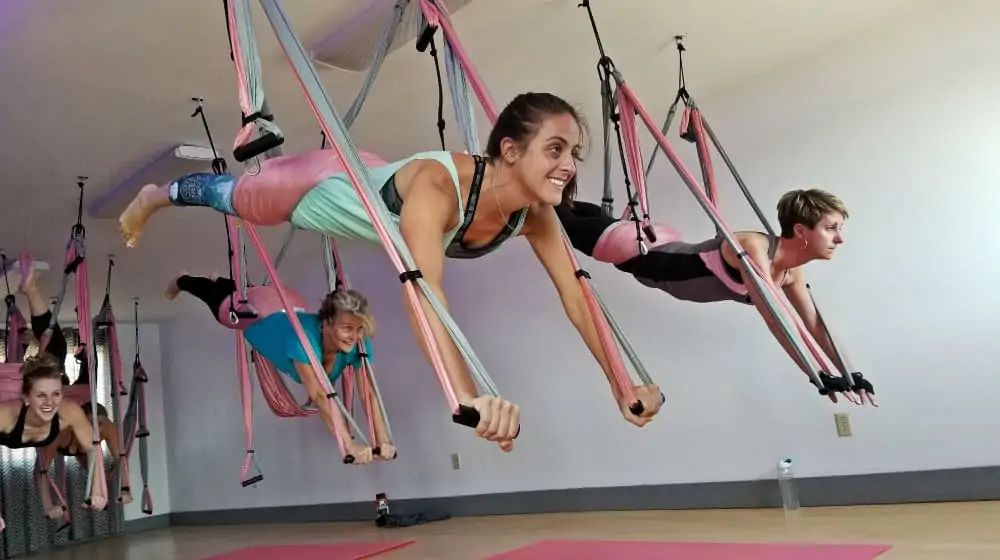
Of all the aerial yoga poses out there, I think this one is the most fun way to gain confidence and feel powerful. Sometimes called “flying spider” or “flying squirrel”, Superman Pose uses yoga swing handles to engage your whole body while also calming your nervous system and allowing you to focus on the breath.
Start by standing with the yoga hammock behind you and bring it to wrap around your midsection. Arch your back and extend your arms to grab hold of the handles. Push down on the handles and bring your legs to levitate behind you. You may need to make a few adjustments as you go.
Namaste!
FAQs
What do you do in a yoga swing?
Most yoga poses can be modified or adjusted in a yoga swing. Superman pose, supported downward dog, inverted pigeon pose, anti-gravity warrior pose, and inverted star are all common beginner aerial yoga poses.
What is a yoga swing good for?
Yoga swings or yoga hammocks are a fun way to practice yoga asanas while defying gravity. You are suspended in the air by a strong, soft fabric hammock that allows you to deeply stretch and practice inversions to decompress your spine and help with back pain.
Is yoga trapeze a good workout?
Depending on how you use it, a yoga swing can be a phenomenal workout for strengthening your core, improving posture, deepening your flexibility, and challenging your arms and legs. Rigorous yoga swing poses and movements will add more challenge and strengthening opportunities.


